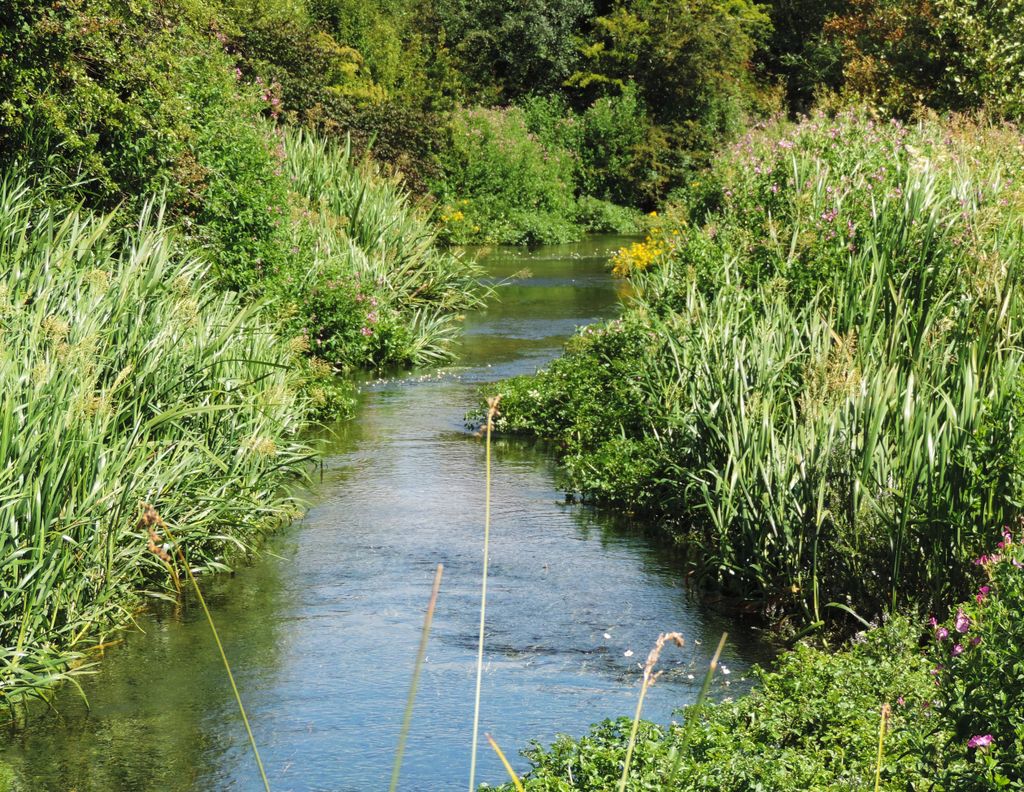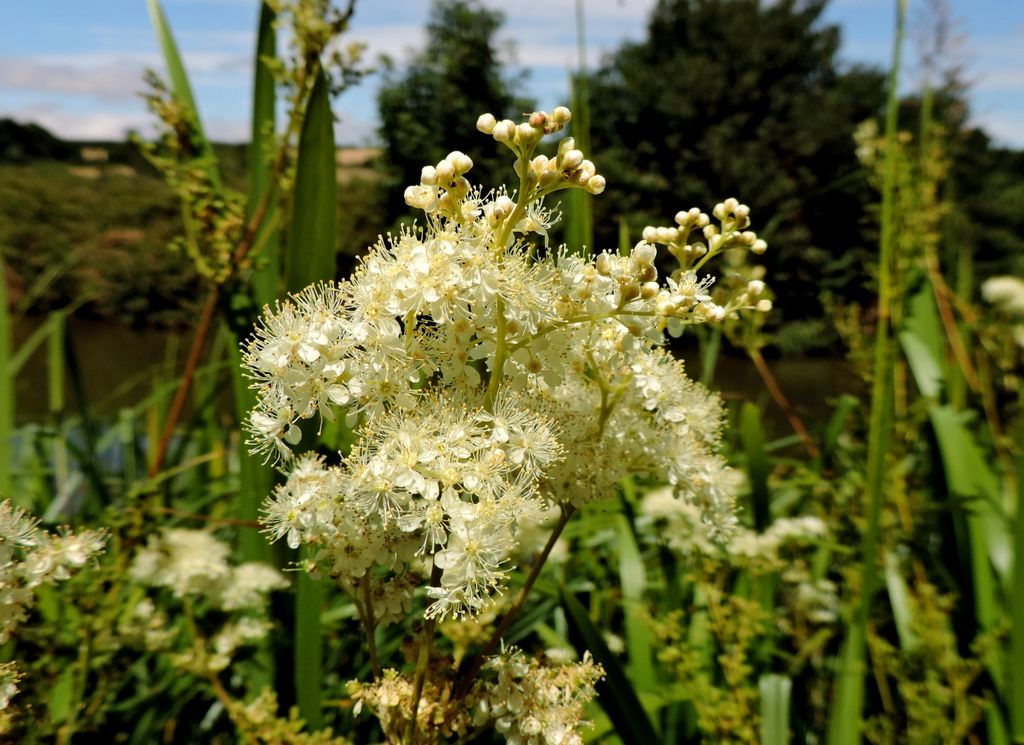Rob Stallard led a walk for twelve people to Hungerford Marshes on Sunday 24th July 2022. This extensive marshy area is fed by the river Dun which is a chalk river that flows from near Great Bedwyn to join the Kennet at Hungerford and so despite the long period of hot and dry weather the marshes still had lush vegetation. The walk started at the Kennet and Avon canal bridge near the church of St. Laurence close to the town centre. Following the canal west a wide range of marsh loving plants were seen including Meadowsweet, Great Willowherb, Water figwort, Gypsywort, Orange Balsam, Greater Tussock-sedge, Perennial Sow-thistle, Branched bur-reed and Wild Angelica. There were also a couple of plants of the rarer umbellifer Lesser Water-parsnip. Further along the mix of plants changed with Red Bartsia, Greater Willowherb, Reed Sweet-grass, Common Fleabane and Square-stalked St. John’s wort. A patch of Water Mint had attracted a good number of Mint Leaf beetles (Chrysolina herbacea). Other insects here included Spiked Shieldbug (Picroderus bidens) and European Cinchbug (Ischnodemus sabuleti). House martins and a buzzard were seen and a Peregrine Falcon flew over the canal.
At the Marsh Lock the group crossed over to explore the main area of Hungerford Marshes that has SSSI designation. The soil type here is a ‘gley’ which is a very fine grained calcareous material that is impervious to water. It is relatively infertile and difficult to plough which has led to the area escaping agricultural development for several centuries. The marsh area was developed as a water meadow where ewes were fattened on spring grass but this practise has ceased long ago. On the north side of the canal a patch of Celery-leaved Buttercup and a Peacock butterfly was seen and a Little Egret was exploring the marshy area near to Willow and Alder carr. A Crow carrying an egg (probably pigeon) was chased by another crow. The overcast skies gradually cleared to give a good deal of sunshine for the rest of the trip.
The bridge over the River Dun gave a good view of plants that prefer flowing water; Blue Water-Speedwell was in profusion as well as River Water-crowfoot, Fool’s Watercress, Water Dock and patches of bright yellow Monkeyflower.
The path took us away from the river to Hopgrass Farm which was the home of the famous naturalist and raconteur Johnny Morris for his last 15 years. Here the river is split into two channels and the group followed the path along the south of the northern channel. From the bridge crossing this channel a Trout was seen.
Along this peaceful stretch of river a good range of marsh and water plants was to be found. At the eastern edge of the river further exploration was blocked by the closure of an unsafe bridge so the group explored the marshy ground to the south where Marsh Ragwort was common. This area had been heavily grazed by cattle. To the south beyond a fence, a reedbed could be seen with large specimens of Water Figwort along the fence line. A Noon Fly (Mesembrina meridiana) was seen on a cow pat and some of the Marsh Ragwort was being nibbled by Cinnabar Moth caterpillars. Tormentil, Silverweed and Brooklime were also noted. A few Marsh Thistles had been infected with the thistle gall fly (Urophora cardui) giving a large swelling on the stems. A Small Tortoiseshell butterfly was seen feeding on Marsh Thistle flowers. The path led to the canal bridge where we had crossed earlier. Three swallows flitted over the water and along the canal towpath a Mint Moth (Pyrausta aurata) and Hedge Bindweed (Calystegia sepium) were spotted. The path brought the group back to the church.







Photographs by Fiona Brown, Tom Walkr and Rob Stallard
|
Plant species found at Hungerford Marshes |
| Achillea millefolium (Yarrow) |
| Angelica sylvestris (Wild Angelica) |
| Apium nodiflorum (Fool’s Watercress) |
| Arctium lappa (Greater Burdock) |
| Argentina anserina (Silverweed) |
| Berula erecta (Lesser Water-parsnip) |
| Caltha palustris (Marsh Marigold) |
| Calystegia silvatica (Large Bindweed) |
| Carex paniculata (Greater Tussock-Sedge) |
| Cerastium fontanum (Common Mouse-ear) |
| Chamerion angustifolium (Rosebay Willowherb) |
| Cirsium palustre (Marsh Thistle) |
| Cirsium arvense (Creeping Thistle) |
| Cirsium vulgare (Spear Thistle) |
| Convolvulus arvensis (Field Bindweed) |
| Epilobium hirsutum (Great Willowherb) |
| Erythranthe guttata (Monkeyflower) |
| Eupatorium cannabinum (Hemp-agrimony) |
| Filipendula ulmaria (Meadowsweet) |
| Galium uliginosum (Fen Bedstraw) |
| Geranium dissectum (Cut-leaved Cranesbill) |
| Glyceria maxima (Reed Sweet-grass) |
| Hypericum tetrapterum (Square-stalked St. John’s-wort) |
| Impatiens capensis (Orange Balsam) |
| Iris pseudacorus (Yellow Iris) |
| Lapsana communis (Nipplewort) |
| Lathyrus pratensis (Meadow Vetchling) |
| Lotus pedunculatus (Greater Bird’s-foot-trefoil) |
| Lycopus europaeus (Gypsywort) |
| Lythrum salicaria (Purple Loosestrife) |
| Marsh Horsetail (Equisetum palustre) |
| Mentha aquatica (Water Mint) |
| Mentha arvensis (Corn Mint) |
| Myosotis scorpioides (Water Forget-me-not) |
| Odontites vernus (Red Bartsia) |
| Oenanthe crocata (Hemlock Water-dropwort) |
| Plantago major (Greater Plantain) |
| Potentilla erecta (Tormentil) |
| Pulicaria dysenterica (Common Fleabane) |
| Ranunculus flammula (Lesser Spearwort) |
| Ranunculus sceleratus (Celery-leaved Crowfoot) |
| Ranunculus fluitans (River Water-crowfoot) |
| Rorippa nasturtium-aquaticum (Water-cress) |
| Rumex hydrolapathum (Great Water Dock) |
| Scabiosa arvensis (Field Scabious) |
| Scophularia auriculata (Water Figwort) |
| Senecio aquaticus (Marsh Ragwort) |
| Sonchus arvensis (Perennial Sow-thistle) |
| Sparganium erectum (Branched Bur-reed) |
| Stachys palustris (Marsh Woundwort) |
| Stachys sylvatica (Hedge Woundwort) |
| Symphytum offinale (Common Comfrey) |
| Torilis japonica (Upright Hedge Parsley) |
| Tussilago farfara (Coltsfoot) |
| Veronica anagallis-aquatica (Blue Water-speedwell) |
| Veronica beccabunga (Brooklime) |
